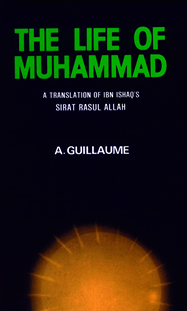The Life of Muhammad A Translation of Ibn Ishaq's Sirat Rasul Allah
Material type: TextLanguage: English Publication details: Karachi : Oxford University Press, c1982Description: XLVII, 813 p. : illISBN:
TextLanguage: English Publication details: Karachi : Oxford University Press, c1982Description: XLVII, 813 p. : illISBN: - 9780196360331
- 297.63 GUI
| Item type | Current library | Shelving location | Call number | Copy number | Status | Date due | Barcode |
|---|---|---|---|---|---|---|---|
 Reference Collection
Reference Collection
|
TIEST (Thar) Library | Computer Science & Information Technology - Thar Institute | 297.63 GUI | 2022-23 | Available | 98154 | |
 Reference Collection
Reference Collection
|
TIEST (Thar) Library | Computer Science & Information Technology - Thar Institute | 297.63 GUI | 2022-23 | Available | 98155 |
About The Author
Muhammad Ibn Ishaq Ibn Yasar Ibn Khiyari (85 AH (704 A.D) - 151 AH (767 A.D)).
According to Guillaume (pp. xiii-xiv), Ibn Ishaq was born circa AH 85, or roughly 704 AD, in Medina. He was the grandson of a man, Yasar, who had been captured in one of Khalid ibn al-Walid's campaigns and taken to Medina as a slave. Yasar converted to Islam and was freed. Yasar's son Ishaq was a traditionist, who collected and recounted tales of the past. Muhammad ibn Ishaq was thus carrying on the work of his father.
At the age of thirty, he travelled to the Islamic province of Egypt to attend lectures given by the traditionalist Yazid ibn Abu Habib , then to Kufa and Hira, and finally to Baghdad, where the Caliph al- Mansur provided him with the means of writing his great work. He died in Baghdad in 151AH (761).
He was the earliest person to write the most comprehensive and most important biography (Sira) of The Prophet Muhammad (P.B.U.H) Sirat Rasullullah.
Ibn Ishaq's work survived only as it was quoted by the later historians Ibn Hisham and Tabari.
Abu Muhammad Abd al-Malik Ibn Hisham was born in Basra and died in Egypt about 60 years after Ibn Ishaq. Ibn Hisham said that he edited this biography and omitted certain details that were deemed too offensive to Muslims.
In 1955, Alfred Guillaume reconstructed the work and published it in English as The Life of Muhammad and tried to reconstruct Ibn Ishaq's manuscript using quotations from other Muslim scholars. This biography provides one of the most important sources of the seerah of Muhammad (SAW).
SUMMARY:
Extensive Contents including Ibn Hisham's Notes, Index of Proper Names, Isnad, Books cited and Subjects
Ibn Ishaq's Sirat Rasul Allah is the earliest surviving traditional biography, and was written just over 100 years after Muhammad's(S) death. It survives in the later editions of Ibn Hisham and al-Tabari.
Professor Guillaume's translation of the Sira of Ibn Ishaq is now reissued. The translator used Ibn Hisham's abridgement and also included many additions and variants found in the writings of early authors. The book thus presents in English practically all that is known of the life of the Prophet.
In the introduction, the translator discusses the character of the Sira in the light of the opinion of early Arabian scholars, noting especially the difficulties of the poetry. As the earliest monument of Arabian prose literature, the Sira remains a work of the first importance.
